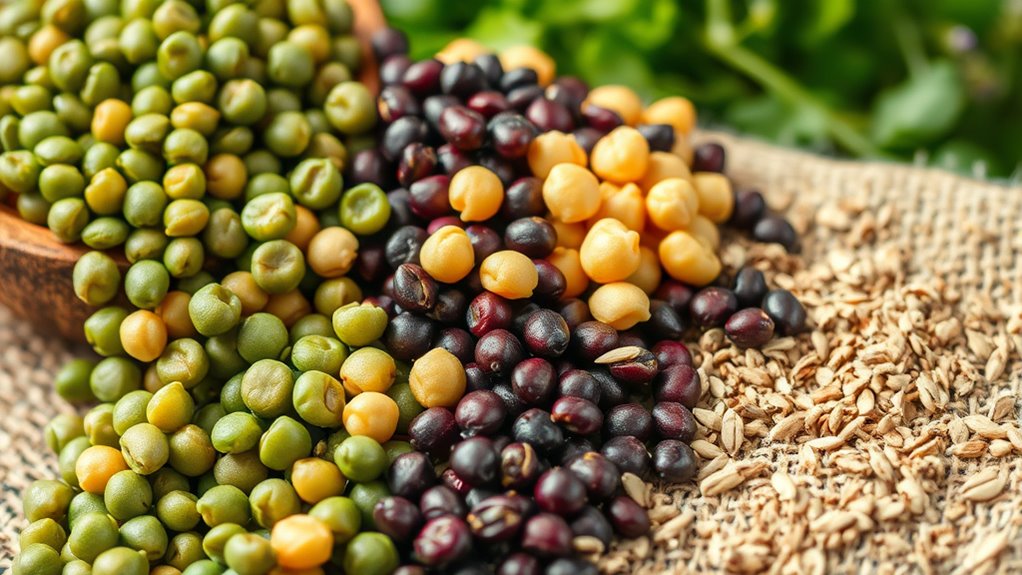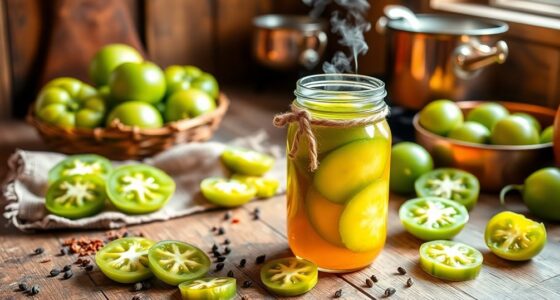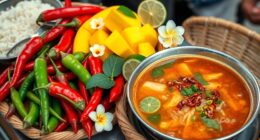There are plenty of plant-based protein options beyond soy to include in your diet. You can try lentils, chickpeas, and quinoa, which are versatile and nutrient-rich. Seeds like chia, hemp, and pumpkin add healthy fats and proteins, while green legumes and pulses support sustainability. For innovative choices, consider insects, algae, and seaweed, which are sustainably farmed and packed with nutrients. Keep exploring for even more tasty and eco-friendly sources to diversify your meals.
Key Takeaways
- Legumes like lentils, chickpeas, and peas offer rich plant protein alternatives to soy, supporting muscle and digestive health.
- Quinoa provides a complete protein with all nine essential amino acids, making it a versatile soy-free option.
- Seeds such as chia, hemp, and pumpkin are nutrient-dense sources of healthy fats and protein, suitable for diverse diets.
- Algae and seaweed are sustainable, oceanic protein sources rich in iodine, minerals, and bioactive compounds.
- Plant-based meat alternatives like seitan and wheat gluten mimic meat textures without soy, expanding protein variety.
Lentils: A Nutrient-Dense Staple

Lentils are a versatile and nutrient-rich plant-based protein source that can easily become a staple in your diet. They are packed with protein, fiber, vitamins, and minerals, making them an excellent choice for supporting your overall health. You can incorporate lentils into soups, salads, stews, or even veggie burgers, adding both texture and nutritional value. Because they cook quickly and don’t require soaking, they’re convenient for busy schedules. Lentils also help regulate blood sugar levels and promote digestive health thanks to their high fiber content. Their mild, earthy flavor pairs well with various spices and ingredients, allowing you to create a wide range of delicious, nutritious meals. Making lentils a regular part of your diet can boost your plant-based protein intake effortlessly. Additionally, their popularity as a traditional ingredient in many cultures highlights their long-standing role in nutritious diets worldwide. Incorporating sustainable and cost-effective protein sources like lentils aligns with environmentally conscious eating habits. As a highly adaptable ingredient, lentils can be integrated into many different cuisines and meal types, enhancing both variety and nutritional value. Including essential nutrients found in lentils can further support overall wellness and meet daily dietary requirements. Furthermore, their high fiber content contributes to overall digestive health, making them a beneficial addition to balanced diets.
Chickpeas and Garbanzo Beans: Versatile and Protein-Rich

Chickpeas and garbanzo beans are packed with protein and essential nutrients that support your health. They’re incredibly versatile, fitting into salads, stews, and snacks with ease. To make the most of them, try simple tips like roasting or blending into spreads to effortlessly boost your meals. Incorporating natural ingredients like wooden utensils can also enhance your cooking experience and preserve the quality of these plant-based proteins.
Nutritional Benefits and Values
Because they are packed with protein and essential nutrients, chickpeas and garbanzo beans stand out as versatile plant-based options. They provide a solid source of plant protein, making them excellent for muscle maintenance and overall health. These beans are rich in dietary fiber, which supports digestion and helps regulate blood sugar levels. They also contain important vitamins and minerals like folate, iron, magnesium, and manganese, contributing to energy production and immune function. Their low fat and calorie content make them a healthy addition to various diets. Additionally, chickpeas offer antioxidants that help combat oxidative stress. Incorporating storage techniques and other quality ingredients and formulations into your meals ensures maximum nutritional benefits. Understanding heat pump technology can help optimize energy efficiency in your home, saving costs and reducing environmental impact. Overall, these beans boost your nutrient intake while supporting long-term health benefits. They’re a nutrient-dense, wholesome option for a balanced plant-based diet.
Culinary Versatility and Uses
Thanks to their mild flavor and firm texture, chickpeas and garbanzo beans are incredibly versatile ingredients that can adapt to a wide range of culinary styles. You can incorporate them into salads, stews, dips, or even roasted snacks. Their neutral taste allows you to season and flavor them in countless ways, making them suitable for various cuisines. Here are some ways to use them:
- Blend into creamy hummus or spreads for snacks and appetizers.
- Toss into salads for added protein and texture.
- Roast with spices for a crunchy, nutritious snack.
- Incorporate into soups and stews to boost flavor and satiety.
- Enhance their nutritional value by pairing them with other plant-based proteins for a well-rounded diet.
Their adaptability makes chickpeas and garbanzo beans valuable staples in your plant-based cooking repertoire.
Easy Incorporation Tips
Incorporating chickpeas and garbanzo beans into your meals is simple and versatile, allowing you to enjoy their health benefits without much hassle. You can toss cooked chickpeas into salads for added texture and protein or blend them into smoothies for extra creaminess. They work well in soups, stews, or as a filling for wraps and veggie bowls. Try mashing them to make hummus or roasting them for a crunchy snack. Canned chickpeas are convenient—just rinse and add directly to your dishes. Dried beans require soaking and cooking but offer more flavor control. Whether you’re making a quick snack or a hearty main, these beans are easy to incorporate, boosting your intake of plant-based protein effortlessly. Additionally, exploring diverse plant-based protein sources can help diversify your diet and maximize health benefits, especially as they can vary in nutritional profiles and culinary uses. Incorporating a variety of these sources can also support your overall nutritional diversity and ensure you receive a broad spectrum of essential nutrients.
Quinoa: The Complete Plant-Based Protein

Have you ever wondered what makes quinoa stand out among plant-based proteins? It’s because quinoa is a complete protein, meaning it contains all nine essential amino acids your body needs. This sets it apart from many other plant sources. Quinoa is also versatile and easy to incorporate into your meals. Here are some key points:
- Rich in protein, with about 8 grams per cooked cup
- Contains all essential amino acids, making it a complete protein
- High in fiber, promoting digestion and satiety
- Packed with vitamins and minerals like magnesium, iron, and B vitamins
- Its status as a versatile superfood highlights its adaptability in various cuisines and dishes
Seeds: Chia, Hemp, and Pumpkin for Power and Nutrition
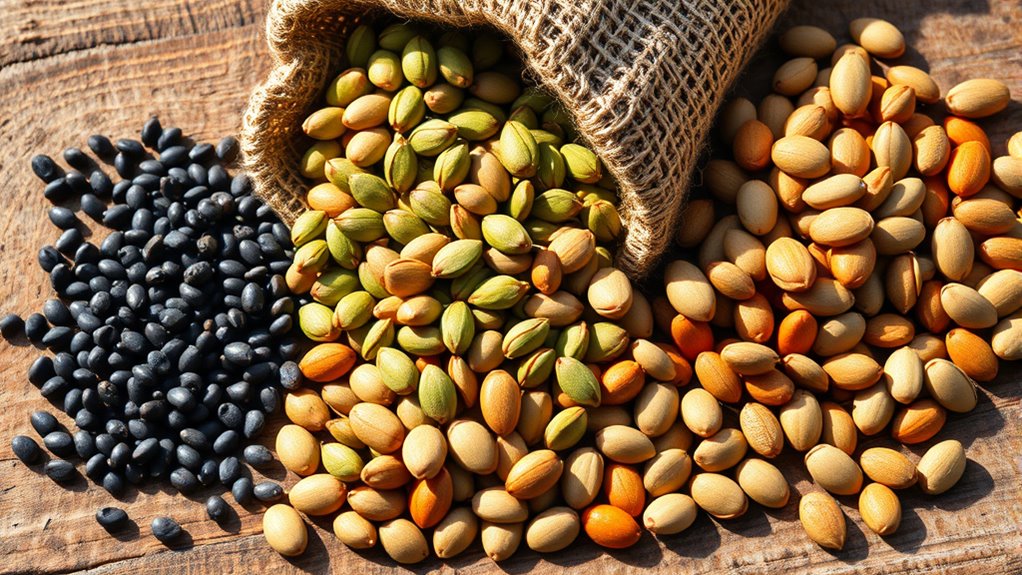
Seeds like chia, hemp, and pumpkin pack a powerful punch of nutrition and energy, making them excellent additions to a plant-based diet. Chia seeds are rich in omega-3 fatty acids, fiber, and antioxidants, supporting digestion and heart health. Hemp seeds provide a complete plant-based protein, containing all nine essential amino acids, along with healthy fats and minerals like magnesium and zinc. Pumpkin seeds, or pepitas, are a great source of zinc, magnesium, and iron, boosting immunity and energy levels. These seeds are versatile; you can sprinkle them on salads, blend them into smoothies, or add them to baked goods. Incorporating these nutrient-dense seeds helps you meet your protein needs while enhancing your diet with healthy fats and crucial micronutrients. raw food principles can help preserve the natural enzymes and nutrients in these seeds, maximizing their health benefits. Additionally, choosing halal-certified seeds ensures compliance with dietary laws and supports mindful consumption. Understanding nutrient preservation techniques can further enhance the benefits of these seeds in your diet, especially when combined with proper storage methods to maintain freshness and potency. Being mindful of processing methods can also ensure you retain the maximum nutritional value during preparation.
Peas and Green Legumes: An Eco-Friendly Protein Source

Peas and green legumes stand out as sustainable and high-quality sources of plant-based protein. They require less water and land than many other crops, making them an eco-friendly choice. You can incorporate peas into your diet through various forms, like fresh, frozen, or processed into protein powders. Their versatility makes them suitable for many recipes, from soups to smoothies. Here are some key benefits:
- High protein content, supporting muscle growth and recovery
- Low environmental impact, conserving resources
- Rich in fiber, aiding digestion and satiety
- Good source of vitamins and minerals, promoting overall health
- Their environmental benefits make them an excellent choice for sustainable eating. Additionally, choosing crops with lower resource requirements can further enhance their positive environmental impact, especially when considering the resource efficiency of different crops. Emphasizing crop diversification can also help maintain soil health and reduce the need for chemical inputs, which aligns with practices that support sustainable agriculture.
Seitan and Wheat Gluten: Plant-Based Meat Alternatives

Seitan and wheat gluten have gained popularity as versatile, plant-based meat alternatives that mimic the texture and flavor of traditional meat. Made from gluten, the main protein in wheat, seitan is known for its chewy, meat-like consistency. You can season it in countless ways, making it adaptable to various recipes like stews, stir-fries, and sandwiches. Its high protein content makes it an excellent option for vegetarians and vegans seeking a hearty, satisfying bite. Seitan is also quick to prepare and widely available at health stores and markets. Because it’s primarily wheat gluten, it’s suitable for many diets, though those with gluten sensitivities should avoid it. Overall, seitan provides a protein-rich, flexible alternative to animal meat, fitting well into plant-based eating plans.
Insects: Sustainable Protein From Edible Bugs
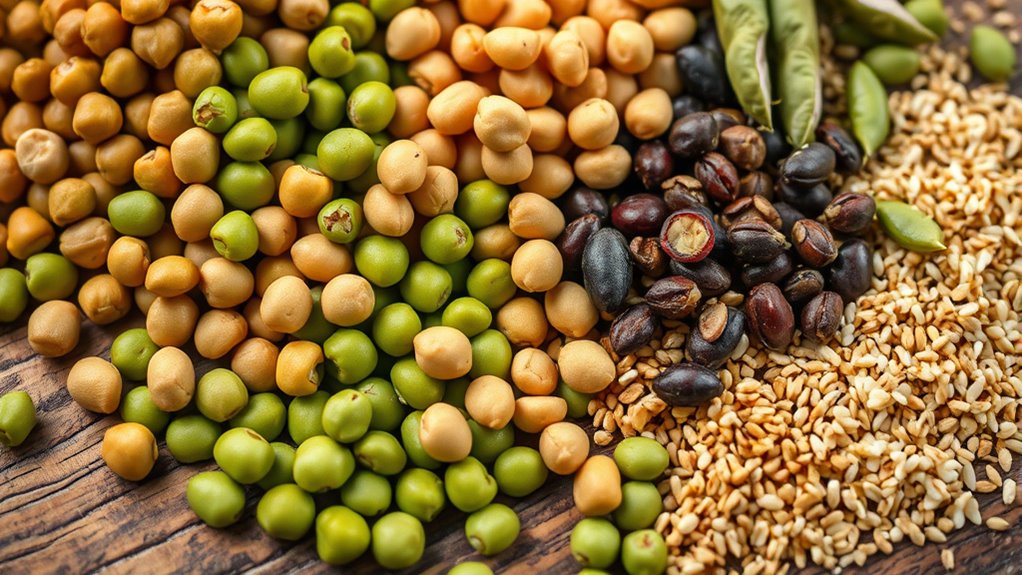
Have you considered insects as a sustainable source of protein? Insects are incredibly efficient to farm, requiring less land, water, and feed than traditional livestock. They grow quickly and produce high-quality protein, making them a practical option for global food security. Here are some key points:
Insects offer a sustainable, efficient, and nutritious alternative to traditional livestock for global food security.
- Environmental impact: Insect farming generates fewer greenhouse gases.
- Nutritional value: Bugs are rich in protein, healthy fats, vitamins, and minerals.
- Feed conversion: Insects convert feed into body mass more efficiently than cattle or pigs.
- Cultural acceptance: While more common in some regions, edible bugs are gaining popularity worldwide.
Insects can help bridge the gap between rising demand and sustainable food production, offering a viable alternative beyond traditional plant-based options.
Algae and Seaweed: Oceanic Sources of Protein and Minerals

Because of their rich nutrient profile and rapid growth, algae and seaweed have become essential oceanic sources of protein and minerals. They offer a sustainable alternative to land-based crops, requiring minimal freshwater and land use. You can incorporate seaweed into your diet through snacks, salads, or supplements, gaining access to high-quality protein, iodine, calcium, magnesium, and iron. These oceanic plants also contain unique compounds like fucoxanthin and omega-3 fatty acids, which support your overall health. Their versatility makes them suitable for various dishes and dietary needs. As a renewable resource, algae and seaweed help reduce environmental impact while providing essential nutrients. By including these superfoods, you can boost your plant-based diet with oceanic goodness that promotes health and sustainability.
Amaranth and Buckwheat: Ancient Grains With Modern Benefits
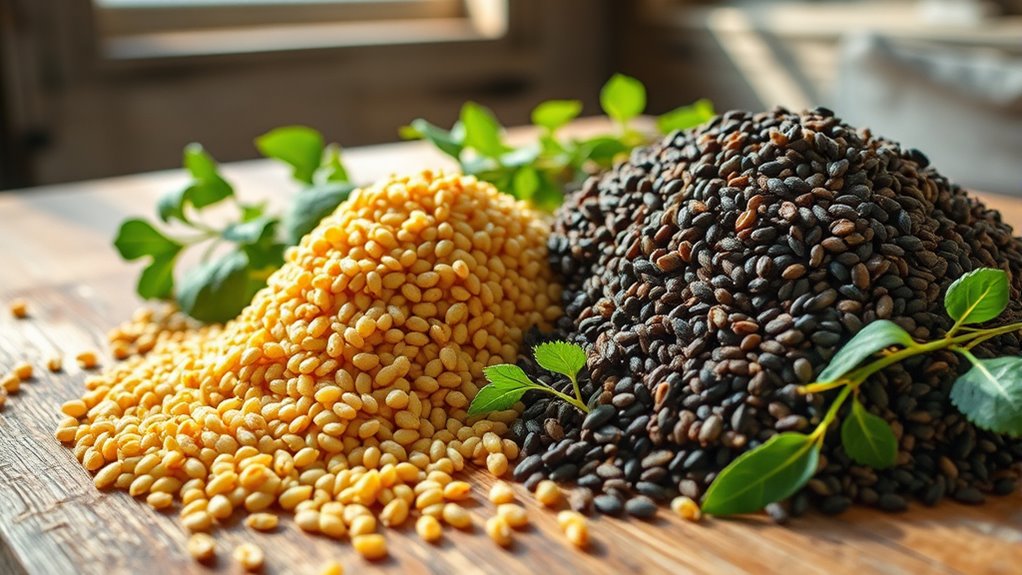
Amaranth and buckwheat are nutritional powerhouses that add value to your diet. They’re naturally gluten-free and can be used in a variety of dishes, making them versatile options. Incorporating these ancient grains lets you enjoy modern health benefits with traditional appeal.
Nutritional Powerhouses in Grains
Ancient grains like amaranth and buckwheat have gained recognition as powerful plant-based protein sources due to their impressive nutrient profiles. You’ll find these grains packed with essential amino acids, making them complete proteins that support muscle growth and overall health. They’re also rich in fiber, aiding digestion and promoting satiety. Furthermore, their antioxidant content helps combat inflammation and oxidative stress. Here are four key benefits:
- Complete protein profiles essential for vegans and vegetarians.
- High fiber content improves digestive health.
- Rich in minerals like magnesium, iron, and zinc.
- Antioxidants that support immune function and reduce inflammation.
Incorporating these ancient grains boosts your nutrient intake, offering modern health benefits rooted in traditional diets.
Gluten-Free and Versatile
If you’re looking for gluten-free grains that are both versatile and nutrient-dense, amaranth and buckwheat stand out as excellent choices. Amaranth offers a complete protein profile, high in fiber, magnesium, and iron, making it a great addition to salads, porridges, or baking. Buckwheat is rich in antioxidants, fiber, and essential minerals like manganese and magnesium, and it works well as a hearty grain alternative in pancakes, noodles, or grain bowls. Both grains are naturally gluten-free, so they suit gluten-sensitive or celiac diets. Their mild, nutty flavors add depth to various dishes, and their adaptability allows you to incorporate them into breakfast, lunch, or dinner recipes effortlessly. These ancient grains provide modern benefits with their nutritional profile and culinary flexibility.
Nuts and Nut Butters: Healthy Fats and Protein in Disguise
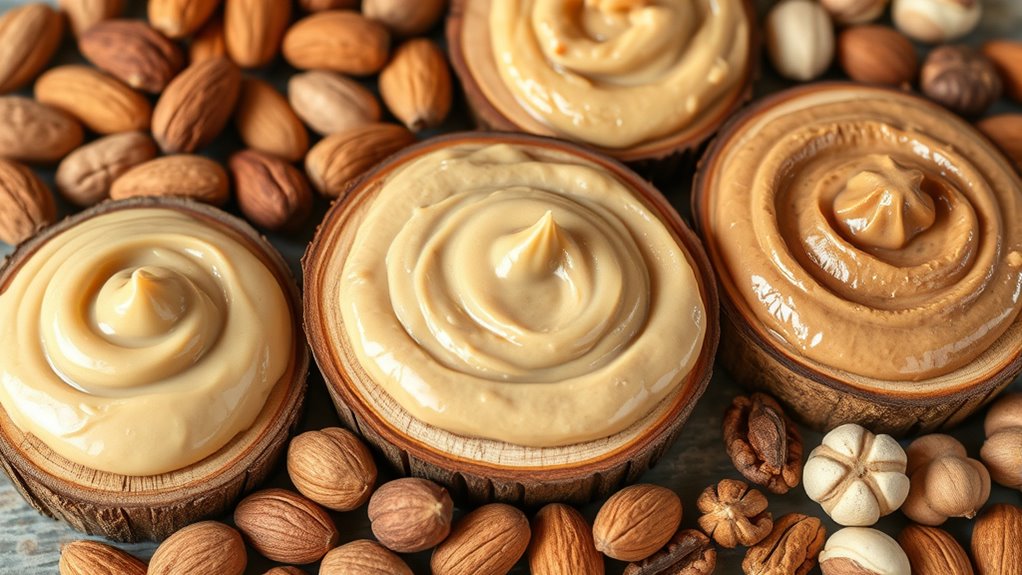
Nuts and nut butters are a delicious way to incorporate healthy fats and plant-based protein into your diet, often serving as convenient snacks or meal additions. They provide essential nutrients that support heart health and energy. When choosing nuts or nut butters, keep these tips in mind:
- Opt for unsweetened, minimally processed options to avoid added sugars and unhealthy ingredients.
- Incorporate a variety of nuts like almonds, walnuts, and cashews for diverse nutrient profiles.
- Use nut butters as spreads, in smoothies, or as a dip to diversify your intake.
- Watch portion sizes, as nuts are calorie-dense but still offer excellent health benefits.
Frequently Asked Questions
Are Plant-Based Proteins Complete Proteins or Do I Need to Combine Sources?
You might wonder if plant-based proteins are complete or if you need to combine sources. Most plant proteins are incomplete, meaning they lack one or more essential amino acids. To get all your amino acids, you should mix different plant proteins, like beans and grains, throughout the day. Don’t worry—by eating a varied diet, you’ll easily meet your protein needs without relying solely on animal products.
How Do Plant Proteins Compare to Animal Proteins in Bioavailability?
Ever wonder how plant proteins stack up against animal proteins in bioavailability? While animal proteins generally have higher bioavailability because they contain all essential amino acids and are easier to digest, some plant proteins are quite close, especially when you combine different sources like grains and legumes. So, with a varied plant-based diet, you can meet your nutritional needs effectively, even if bioavailability isn’t always on par with animal proteins.
Can Plant-Based Proteins Support Muscle Building and Athletic Performance?
You can definitely support muscle building and athletic performance with plant-based proteins. While they may have slightly lower bioavailability than animal proteins, many plant sources like beans, lentils, quinoa, and chickpeas provide essential amino acids. Combining different plant proteins or consuming adequate amounts guarantees you get enough protein to fuel your workouts and aid recovery. With proper planning, plant-based diets can be just as effective for muscle growth and athletic achievement.
What Are the Best Plant-Based Protein Sources for Children and Pregnant Women?
Ever wonder which plant-based proteins suit children and pregnant women best? You should focus on nutrient-rich options like lentils, chickpeas, quinoa, hemp seeds, and chia seeds. These foods provide essential amino acids, iron, and healthy fats crucial for growth and development. Are you ensuring a diverse diet? Incorporate a variety of these sources to meet the increased nutritional needs of both children and expectant mothers.
Are There Any Potential Allergenic Risks With Plant-Based Protein Sources?
You should be aware that some plant-based protein sources can pose allergenic risks, especially for those with sensitivities. For example, nuts, seeds, and legumes like lentils and chickpeas may trigger allergic reactions. Always check ingredient labels and consult with a healthcare professional if you or your family members have known allergies. Taking these precautions helps you enjoy plant-based proteins safely and reduces potential health risks.
Conclusion
So, as you explore these plant-powered treasures, think of your plate as a vibrant garden thriving beyond soy. Each source is like a new brushstroke on your culinary canvas, adding color, texture, and life. Embrace the diversity — from hearty lentils to ocean’s hidden gems — and let your meals become a symphony of sustainable, nourishing flavors. Your journey to plant-based protein is an adventure waiting to unfold, one delicious bite at a time.
